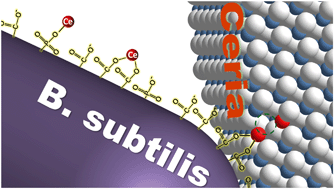Bacillus subtilis causes dissolution of ceria nanoparticles at the nano–bio interface†
Abstract
The cytotoxicity of ceria nanoparticles (NPs) against microorganisms was identified as a particle-specific toxicity in previous work since no release of Ce3+ ions was evident. Although the literature has demonstrated a reduction of ceria NPs after their interaction with bacteria, it remains unknown whether the reduction is followed by a release of Ce3+ ions from the particle surface. The present work aims to study whether there is dissolution of ceria NPs at the nano–bio interface and evaluate the possible ionic toxicity against bacteria. Our results suggest that rod-like ceria NPs could be reduced by Bacillus subtilis under planktonic conditions, then the Ce3+ ions adjacent to the surface oxygen vacancies would be chelated by the adsorption sites on the bacterial cell wall and extracted from the particles. The biosorption of the dissolved Ce3+ ions by bacteria is further confirmed by the Ce3+ desorption after the protonation of carboxyl groups on the cell wall. Therefore, we demonstrate for the first time the dissolution of ceria NPs at the bacterial surface as a result of the nano–bio interaction. These findings together reveal a combined mechanism for the toxicity of ceria NPs: particle-related delivery of Ce to the bacterial surface and ion-related toxicity following the dissolution. This insight would benefit our understanding of the mechanism underlying the cytotoxicity of ceria NPs.



 Please wait while we load your content...
Please wait while we load your content...